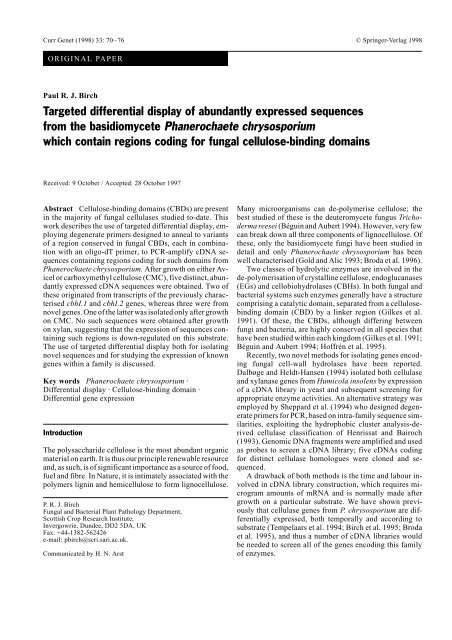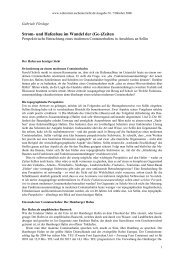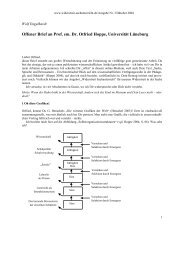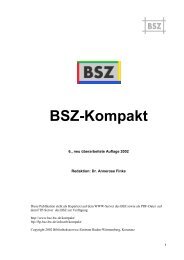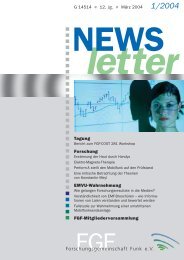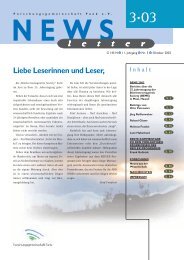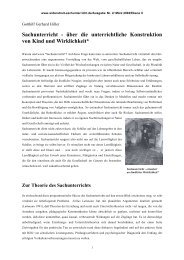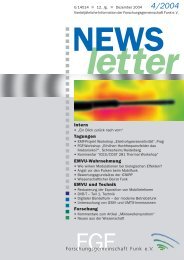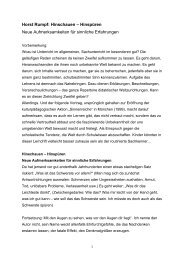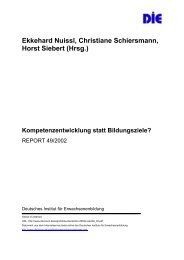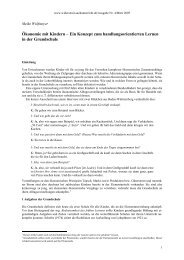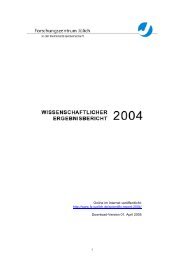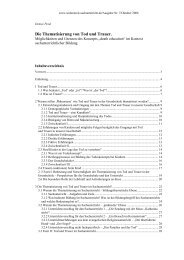Targeted differential display of abundantly expressed sequences ...
Targeted differential display of abundantly expressed sequences ...
Targeted differential display of abundantly expressed sequences ...
Create successful ePaper yourself
Turn your PDF publications into a flip-book with our unique Google optimized e-Paper software.
Curr Genet (1998) 33: 70–76 © Springer-Verlag 1998<br />
ORIGINAL PAPER<br />
Paul R. J. Birch<br />
<strong>Targeted</strong> <strong>differential</strong> <strong>display</strong> <strong>of</strong> <strong>abundantly</strong> <strong>expressed</strong> <strong>sequences</strong><br />
from the basidiomycete Phanerochaete chrysosporium<br />
which contain regions coding for fungal cellulose-binding domains<br />
Received: 9 October / Accepted: 28 October 1997<br />
Abstract Cellulose-binding domains (CBDs) are present<br />
in the majority <strong>of</strong> fungal cellulases studied to-date. This<br />
work describes the use <strong>of</strong> targeted <strong>differential</strong> <strong>display</strong>, employing<br />
degenerate primers designed to anneal to variants<br />
<strong>of</strong> a region conserved in fungal CBDs, each in combination<br />
with an oligo-dT primer, to PCR-amplify cDNA <strong>sequences</strong><br />
containing regions coding for such domains from<br />
Phanerochaete chrysosporium. After growth on either Avicel<br />
or carboxymethyl cellulose (CMC), five distinct, <strong>abundantly</strong><br />
<strong>expressed</strong> cDNA <strong>sequences</strong> were obtained. Two <strong>of</strong><br />
these originated from transcripts <strong>of</strong> the previously characterised<br />
cbhI.1 and cbhI.2 genes, whereas three were from<br />
novel genes. One <strong>of</strong> the latter was isolated only after growth<br />
on CMC. No such <strong>sequences</strong> were obtained after growth<br />
on xylan, suggesting that the expression <strong>of</strong> <strong>sequences</strong> containing<br />
such regions is down-regulated on this substrate.<br />
The use <strong>of</strong> targeted <strong>differential</strong> <strong>display</strong> both for isolating<br />
novel <strong>sequences</strong> and for studying the expression <strong>of</strong> known<br />
genes within a family is discussed.<br />
Key words Phanerochaete chrysosporium ·<br />
Differential <strong>display</strong> · Cellulose-binding domain ·<br />
Differential gene expression<br />
Introduction<br />
The polysaccharide cellulose is the most abundant organic<br />
material on earth. It is thus our principle renewable resource<br />
and, as such, is <strong>of</strong> significant importance as a source <strong>of</strong> food,<br />
fuel and fibre. In Nature, it is intimately associated with the<br />
polymers lignin and hemicellulose to form lignocellulose.<br />
P. R. J. Birch<br />
Fungal and Bacterial Plant Pathology Department,<br />
Scottish Crop Research Institute,<br />
Invergowrie, Dundee, DD2 5DA, UK<br />
Fax: +44-1382-562426<br />
e-mail: pbirch@scri.sari.ac.uk.<br />
Communicated by H. N. Arst<br />
Many microorganisms can de-polymerise cellulose; the<br />
best studied <strong>of</strong> these is the deuteromycete fungus Trichoderma<br />
reesei (Béguin and Aubert 1994). However, very few<br />
can break down all three components <strong>of</strong> lignocellulose. Of<br />
these, only the basidiomycete fungi have been studied in<br />
detail and only Phanerochaete chrysosporium has been<br />
well characterised (Gold and Alic 1993; Broda et al. 1996).<br />
Two classes <strong>of</strong> hydrolytic enzymes are involved in the<br />
de-polymerisation <strong>of</strong> crystalline cellulose, endoglucanases<br />
(EGs) and cellobiohydrolases (CBHs). In both fungal and<br />
bacterial systems such enzymes generally have a structure<br />
comprising a catalytic domain, separated from a cellulosebinding<br />
domain (CBD) by a linker region (Gilkes et al.<br />
1991). Of these, the CBDs, although differing between<br />
fungi and bacteria, are highly conserved in all species that<br />
have been studied within each kingdom (Gilkes et al. 1991;<br />
Béguin and Aubert 1994; H<strong>of</strong>frén et al. 1995).<br />
Recently, two novel methods for isolating genes encoding<br />
fungal cell-wall hydrolases have been reported.<br />
Dalbøge and Heldt-Hansen (1994) isolated both cellulase<br />
and xylanase genes from Humicola insolens by expression<br />
<strong>of</strong> a cDNA library in yeast and subsequent screening for<br />
appropriate enzyme activities. An alternative strategy was<br />
employed by Sheppard et al. (1994) who designed degenerate<br />
primers for PCR, based on intra-family sequence similarities,<br />
exploiting the hydrophobic cluster analysis-derived<br />
cellulase classification <strong>of</strong> Henrissat and Bairoch<br />
(1993). Genomic DNA fragments were amplified and used<br />
as probes to screen a cDNA library; five cDNAs coding<br />
for distinct cellulase homologues were cloned and sequenced.<br />
A drawback <strong>of</strong> both methods is the time and labour involved<br />
in cDNA library construction, which requires microgram<br />
amounts <strong>of</strong> mRNA and is normally made after<br />
growth on a particular substrate. We have shown previously<br />
that cellulase genes from P. chrysosporium are <strong>differential</strong>ly<br />
<strong>expressed</strong>, both temporally and according to<br />
substrate (Tempelaars et al. 1994; Birch et al. 1995; Broda<br />
et al. 1995), and thus a number <strong>of</strong> cDNA libraries would<br />
be needed to screen all <strong>of</strong> the genes encoding this family<br />
<strong>of</strong> enzymes.
A number <strong>of</strong> PCR-based methods for rapidly comparing<br />
pr<strong>of</strong>iles <strong>of</strong> gene expression have been reported. One<br />
such method, <strong>differential</strong> <strong>display</strong> (DDRT-PCR), involves<br />
the random amplification <strong>of</strong> <strong>sequences</strong> from cDNA populations<br />
<strong>of</strong> interest using short oligonucleotide primers in<br />
combination with primers which anneal to the polyA tail<br />
<strong>of</strong> the cDNA; amplification products are then directly compared<br />
on polyacrylamide gels (Liang and Pardee 1992).<br />
Here, the DDRT-PCR approach has been modified to<br />
screen specifically for <strong>sequences</strong> containing regions encoding<br />
CBDs from P. chrysosporium, after growth on three<br />
different carbon (C) sources. In this case, the short primers<br />
used for DDRT-PCR are replaced by longer degenerate<br />
primers designed to anneal to a conserved region <strong>of</strong> the<br />
CBD-encoding sequence, allowing the annealing temperature<br />
<strong>of</strong> the PCR reaction to be elevated, and thus to be<br />
more specific. CBDs are present in the majority <strong>of</strong> fungal<br />
cellulases studied to-date and have also been reported in a<br />
xylanase from H. insolens (Dalbøge and Heldt-Hansen<br />
1994), a β mannanase (Stålbrand et al. 1995) and an acetyl<br />
xylan esterase (Margolles-Clark et al. 1996) from T. reesei.<br />
Materials and methods<br />
Organism and culture media. P. chrysosporium ME446 (ATCC<br />
34541) was maintained on 2% (w/v) slopes malt-extract agar. The<br />
culture medium was a modified Vogel’s medium as described previously<br />
(Tempelaars et al. 1994), containing 0.2% (w/v) <strong>of</strong> a carbon<br />
source from Avicel (microcrystalline cellulose), carboxymethyl cellulose<br />
(CMC) (amorphous cellulose) or oatspelt arabinoxylan.<br />
DNA manipulations. DNA was extracted from P. chrysosporium as<br />
described by Raeder and Broda (1985). Southern blotting was onto<br />
Hybond N membrane (Amersham) and hybridisation was performed<br />
using the low-stringency conditions described in Sambrook et al.<br />
(1989). All techniques referred to below were according to the<br />
manufacturers’ recommendations. Colony hybridisations were made<br />
on Hybond C extra membrane (Amersham). PCR-amplified DNA<br />
fragments were purified for cloning using the Promega Wizard PCR<br />
Preps kit. PCR-amplified DNA was cloned using the pGEM-T vector<br />
cloning kit (Promega) and transformed into Stratagene Ultracompetent<br />
Epicurian coli XL2-blue MRF′ cells. Plasmid preparations<br />
were made using the Qiagen Plasmid Miniprep kit. Sequencing <strong>of</strong><br />
cloned PCR products was performed using the ABI PRISM Dye Terminator<br />
cycle sequencing kit <strong>of</strong> Perkin Elmer. The 32 P-radiolabelled<br />
probe DNA was prepared using the Random Primed Labelling kit <strong>of</strong><br />
Pharmacia.<br />
RNA extraction and cDNA synthesis. P. chrysosporium was inoculated<br />
into liquid culture as previously described and the mycelium<br />
was harvested after 4-days stationary incubation at 37°C (Tempelaars<br />
et al. 1994). The mycelium was ground under liquid nitrogen<br />
and RNA extracted using the Qiagen RNeasy kit. Poly (A) + mRNA<br />
was purified from this with a Dynal’s Dynabeads mRNA extraction<br />
kit. cDNA was synthesised from mRNA with the Pharmacia First-<br />
Strand cDNA synthesis kit, using the NotI primer supplied with the<br />
kit.<br />
Design <strong>of</strong> PCR primers and RT-PCR conditions for targeted <strong>differential</strong><br />
<strong>display</strong>. Figure 4 shows an alignment <strong>of</strong> the amino-acid <strong>sequences</strong><br />
<strong>of</strong> 30 previously published fungal CBD regions. From amino-acid<br />
positions 2–8, 25 <strong>of</strong> these vary only at position 7, involving<br />
<strong>sequences</strong> GQCGGI/N/QG. Three degenerate oligonucleotide primers<br />
were designed to anneal to DNA <strong>sequences</strong> coding for these regions.<br />
Primer 1 (5′-GGNCAGTGCGGNGGNATPyGG-3′) anneals<br />
to <strong>sequences</strong> coding for GQCGGIG, primer 2 (5′-GGNCAGTGC<br />
GGNGGNCAGGG-3′) anneals to <strong>sequences</strong> coding for GQCGGQG,<br />
and primer 3 (5′-GGNCAGTGCGGNGGNAAPyGG-3′) anneals to<br />
<strong>sequences</strong> coding for GQCGGNG. On the basis <strong>of</strong> codon usage in<br />
known P. chrysosporium genes, the codon CAG was employed for<br />
amino-acid Q. Each <strong>of</strong> these primers was used independently in<br />
DDRT-PCR reactions with a primer which anneals to the poly-A tail<br />
(5′-ATTCGCGGCCGCAGGAT 15 ), which is derived from the Pharmacia<br />
NotI dT primer used for cDNA synthesis. Primer 4<br />
(5′-GCACTGCGAGTAGTA-3′) was used in combination with primer<br />
1 to PCR-amplify the region coding for the CBD from the cbhI.1<br />
gene <strong>of</strong> P. chrysosporium, cloned in 3E2D (Sims et al. 1994). The<br />
cbhII upstream primer, 5′-CCTCAGCCCTTACTACGC-3′, was as<br />
used for RT-PCR in Tempelaars et al. (1994) with an annealing temperature<br />
<strong>of</strong> 55°C. To prevent primers 1–3 acting as RAPD primers,<br />
generating PCR products in the absence <strong>of</strong> any other primer, an annealing<br />
temperature <strong>of</strong> 65°C was employed. The RT-PCR conditions<br />
were: one cycle <strong>of</strong> 94°C for 1 min, 65°C for 1 min, 72°C for 2 min;<br />
30 cycles <strong>of</strong> 94°C for 30 s, 65°C for 30 s, 72°C for 1.5 min, and a<br />
cycle <strong>of</strong> 72°C for 10 min.<br />
Results<br />
Isolation <strong>of</strong> cDNA <strong>sequences</strong> which hybridise<br />
to the CBD-encoding region <strong>of</strong> cbhI.1<br />
from P. chrysosporium ME446<br />
71<br />
P. chrysosporium was grown for 4 days at 37°C in medium<br />
containing either Avicel, CMC, or oatspelt arabinoxylan.<br />
The rationale for choosing these C sources is that Avicel<br />
is commonly regarded as an exocellulase substrate, CMC<br />
as an endocellulase substrate, while xylan is the major component<br />
<strong>of</strong> hemicellulose; the expression <strong>of</strong> different components<br />
<strong>of</strong> the lignocellulolytic system has been shown to<br />
occur after growth on each (Broda et al. 1995). cDNA was<br />
synthesised from poly (A) + mRNA prepared from mycelia<br />
grown on each medium and, in each case, 50 ng was<br />
used in PCR reactions containing either CBD primer 1, 2<br />
or 3, each in combination with an oligo-dT primer which<br />
anneals specifically to the poly-A tail <strong>of</strong> cDNA.<br />
Initially, however, to test whether, under all conditions,<br />
intact mRNA had been extracted and converted to cDNA,<br />
RT-PCR was performed using a primer which anneals to<br />
the cbhII gene <strong>of</strong> P. chrysosporium in combination with<br />
the oligo-dT primer. This cellulase gene is <strong>expressed</strong> after<br />
growth on Avicel, CMC, and xylan (Tempelaars et al. 1994)<br />
and thus cDNA derived from it should be detected in each<br />
sample. This proved to be the case, and a PCR product <strong>of</strong><br />
a size expected from cbhII cDNA using these primers, approximately<br />
1.4 kb, was generated from each cDNA sample,<br />
whereas no such product was generated from genomic<br />
DNA (Fig. 1).<br />
To test whether the products amplified, using CBD<br />
primers 1, 2 or 3 with the oligo-dT primer, contained <strong>sequences</strong><br />
which share homology with a CBD-encoding region,<br />
each population <strong>of</strong> PCR products was separated by<br />
gel electrophoresis. These were then Southern blotted and<br />
hybridised, using low-stringency conditions, to a probe derived<br />
from the P. chrysosporium cbhI.1 gene. To prepare
72<br />
Fig. 1 PCR amplification with a primer which anneals to the cbhII<br />
gene <strong>of</strong> P. chrysosporium, in combination with the oligo-dT primer,<br />
using cDNA prepared after growth on Avicel (2), CMC (3) or xylan<br />
(4), or genomic DNA (1) as the template. The size <strong>of</strong> the cbhII cDNAamplification<br />
product in base pairs is given to the right <strong>of</strong> the<br />
panel<br />
Fig. 2A,B PCR amplification products (the left half <strong>of</strong> each panel),<br />
generated using either CBD-specific primer 1 (panel A) or primer<br />
2 (panel B) each in combination with the oligo-dT primer. Templates<br />
were either genomic DNA from P. chrysosporium (lane 1), or<br />
cDNA prepared after growth on either Avicel (2), CMC (3) or xylan<br />
(4), or no template (negative control; 5). The right half <strong>of</strong> each panel<br />
shows Southern hybridisation, under low-stringency conditions,<br />
<strong>of</strong> DNA transferred from each <strong>of</strong> these agarose gels to a probe derived<br />
from the CBD-encoding region <strong>of</strong> cbhI.1 from P. chrysosporium.<br />
Size markers are given in base pairs to the right <strong>of</strong> each panel<br />
this probe, primers 1 and 4 were used to amplify from position<br />
1452 to 1548, containing the CBD-encoding region<br />
<strong>of</strong> the cbhI.1 cDNA sequence cloned into plasmid 3E2D<br />
(Sims et al. 1994). Amplification products obtained from<br />
cDNA prepared after growth on either Avicel or CMC, using<br />
either primer 1 or primer 2, strongly hybridised to <strong>sequences</strong><br />
<strong>of</strong> between 200 and 400 bp (Fig. 2). However,<br />
only weak hybridisation was observed to xylan-derived<br />
PCR products. In all cases, amplification products were<br />
obtained which failed to hybridise to the probe (Fig. 2).<br />
Only very weak hybridisation was observed to amplification<br />
products obtained using primer 3, and these products<br />
were thus excluded from further analyses (data not shown).<br />
To isolate <strong>sequences</strong> which hybridise to the CBD probe,<br />
each population <strong>of</strong> amplification products, obtained after<br />
amplification with either primer 1 or 2 from cDNA derived<br />
from P. chrysosporium grown on Avicel, CMC or xylan,<br />
was shotgun-cloned into the vector pGEM-T. One-hundred<br />
white colonies from each cloning event were screened by<br />
low-stringency hybridisation to the CBD probe. Several<br />
strongly hybridising clones were obtained from cDNAs<br />
amplified after growth on either Avicel or CMC. However,<br />
only weakly hybridising clones were obtained from<br />
cDNAs amplified after growth on xylan. Plasmid DNA was<br />
prepared for sequence analysis from both strongly and<br />
weakly hybridising colonies.<br />
Sequence analysis <strong>of</strong> cloned cDNAs which hybridise<br />
to the CBD probe<br />
Sequences derived from weakly hybridising clones contained<br />
no open reading frames (ORFs) which shared identity<br />
with known fungal CBDs (data not shown). However,<br />
such <strong>sequences</strong> were obtained from all strongly hybridising<br />
colonies. Using primer 1 with the oligo-dT primer,<br />
three different CBD-encoding <strong>sequences</strong> were identified<br />
(Fig. 3). Two <strong>of</strong> these contain <strong>sequences</strong> matching the previously<br />
published cbhI.1 and cbhI.2 genes (Fig. 3 A and B<br />
respectively). However, the third sequence obtained is<br />
novel (Fig. 3 C). The lengths <strong>of</strong> the <strong>sequences</strong> varied, from<br />
220 bp in the case <strong>of</strong> the region amplified from cbhI.1, to<br />
approximately 370 bp in the case <strong>of</strong> ac1 (Fig. 3 C). This<br />
was expected, as the CBD probe had hybridised to fragments<br />
<strong>of</strong> 200–400 bp (see above; Fig. 2 A). Variation in<br />
sequence length was most pronounced in amplification<br />
products derived from cbhI.1; four sites <strong>of</strong> polyadenylation<br />
were observed (Fig. 3 A), resulting in fragments from<br />
220- to 260-bp long.<br />
Two different classes <strong>of</strong> <strong>sequences</strong> containing CBD-encoding<br />
ORFs were obtained using primer 2 with the oligodT<br />
primer. Each <strong>of</strong> these represents a novel sequence<br />
(Fig. 3 D and E). Clones containing sequence ac2 were approximately<br />
210-bp long, whereas those containing cmc1<br />
were approximately 240-bp long. Again, these sizes are in<br />
agreement with the hybridisation reported in Fig. 2 B.<br />
Table 1 shows the number <strong>of</strong> each class <strong>of</strong> sequence obtained<br />
as a percentage <strong>of</strong> the colonies screened by hybridisation.<br />
Sequences matching cbhI.1 and cbhI.2, and novel<br />
<strong>sequences</strong> ac1 and ac2, were all amplified from cDNAs<br />
prepared after growth on both Avicel and CMC. In contrast,<br />
sequence cmc1 was only detected in cDNAs prepared<br />
after growth on CMC. With the exception <strong>of</strong> cmc1, the sequence<br />
differences between clones suggested that both alleles<br />
<strong>of</strong> each sequence were identified (Fig. 3). To allow<br />
for differences arising from PCR, such allelic differences<br />
were based on consistent nucleotide differences being observed<br />
in two or more clones <strong>of</strong> each class <strong>of</strong> transcript for<br />
Table 1 Number <strong>of</strong> clones (%) isolated <strong>of</strong> each CBD-encoding sequence<br />
Sequence Number <strong>of</strong> clones sequenced (%)<br />
Avicel CMC Xylan<br />
cbhI.1 26 21 0<br />
cbhI.2 16 19 0<br />
ac1 2 3 0<br />
ac2 10 7 0<br />
cmc1 0 12 0
73<br />
Fig. 3 A–E DNA <strong>sequences</strong><br />
<strong>of</strong> each <strong>of</strong> the five classes <strong>of</strong><br />
amplified cDNA fragments<br />
containing CBD-encoding regions<br />
(A–E), where A = cbhI.1,<br />
B = cbhI.2, C = ac1, D = ac2<br />
and E = cmc1. Differences<br />
between alleles are indicated by<br />
underlining and the alternative<br />
base is given beneath. Underlining<br />
<strong>of</strong> a base with a star (*)<br />
beneath indicates alternative<br />
positions at which the poly-A<br />
tail is added. The predicted<br />
amino-acid sequence is shown<br />
above the corresponding coding<br />
sequence (capital letters). The<br />
sequence in bold represents a<br />
sequence present in one allele<br />
<strong>of</strong> the cbhI.2 gene (B) which is<br />
absent in the other. Alternative<br />
stop codons in <strong>differential</strong>ly<br />
spliced transcripts <strong>of</strong> each allelic<br />
variant <strong>of</strong> cbhI.2 (B) are indicated<br />
in both bold and italics
from P. chrysosporium, or from unspliced transcripts <strong>of</strong><br />
cbhI.1 and cbhI.2. Firstly, more abundant classes <strong>of</strong> transcript<br />
may out-compete rarer classes in the PCR. Such competition<br />
may explain the failure to detect unspliced transcripts<br />
<strong>of</strong> cbhI.1 and cbhI.2, as the fully spliced transcripts<br />
are more <strong>abundantly</strong> synthesised after growth on these substrates<br />
and may thus have out-competed them (Sims et al.<br />
1994; Birch et al. 1995). Such a bias <strong>of</strong> DDRT-PCR towards<br />
high copy number cDNAs has been demonstrated<br />
previously (Bertioli et al. 1995). Secondly, there may be<br />
insufficient identity between the degenerate primers and<br />
the CBD-encoding regions within the cellulase genes. This<br />
is the case for the cbh1-2 gene, which contains a region<br />
coding for SQCGGLG; this differs from equivalent <strong>sequences</strong><br />
chosen for the design <strong>of</strong> primers 1, 2 and 3 and,<br />
indeed, is different to analogous regions in any other<br />
known fungal CBD (Fig. 4). Thirdly, the CBD-encoding<br />
regions <strong>of</strong> all <strong>sequences</strong> isolated in this study are located<br />
at the 3′ ends <strong>of</strong> the ORF. In the case <strong>of</strong> cbhII, this region<br />
is present at the 5′ end <strong>of</strong> the ORF. Use <strong>of</strong> a specific primer<br />
for cbhII confirmed that cDNAs derived from this gene<br />
were present in samples prepared after growth on Avicel,<br />
CMC, and xylan. However, when using CBD-specific<br />
primer 1, cbhII cDNA templates were out-competed in all<br />
PCR reactions by templates yielding smaller amplification<br />
products, including those from cbhI.1 and cbhI.2 in the<br />
cases <strong>of</strong> Avicel and CMC. Although such competition may<br />
be due simply to different levels <strong>of</strong> gene expression, the<br />
abundance <strong>of</strong> cbhII templates relative to those from cbhI.1<br />
and cbhI.2 may also be effected by the efficiency <strong>of</strong> cDNA<br />
synthesis, which is primed from the 3′ end <strong>of</strong> mRNA. In<br />
addition, the larger PCR product predicted from cbhII<br />
cDNA may be amplified less efficiently than the small PCR<br />
products isolated in this study. Both <strong>of</strong> these factors should<br />
be considered when designing degenerate primers to target<br />
a family <strong>of</strong> genes. It is thus recommended that conserved<br />
<strong>sequences</strong> should be sought which are present at<br />
only one location in all known genes in the family and that<br />
the location should be as near to the 3′ end as possible.<br />
Interestingly, partial protein sequence from one <strong>of</strong> the<br />
EGs produced by P. chrysosporium, EG1, has revealed an<br />
N-terminal CBD containing the sequence GQCGGIG<br />
(Uzcategui et al. 1991 b), identical to those encoded by<br />
equivalent nucleotides in cbhI.1, cbhI.2 and cbhII, from<br />
which primer 1 was designed. As was the case for cbhII,<br />
however, cDNAs coding for this gene were also not detected.<br />
Further work will be required to identify the genes from<br />
which the three novel cDNAs containing CBD-encoding<br />
regions are derived. However, they may originate from<br />
transcripts <strong>of</strong> the partially characterised cbh1-5 and<br />
cbh1-6 (Covert et al. 1992 b) genes, or from the gene that<br />
is predicted to code for both EG38 and EG36 (Uzcategui<br />
et al. 1991 a). Indeed, although Northern analysis would<br />
be required to confirm patterns <strong>of</strong> regulation for these<br />
genes, one sequence isolated in this study, cmc1, was amplified<br />
only from cDNA prepared after growth on CMC,<br />
which is commonly regarded as an EG substrate. In addition,<br />
a cellulose-binding β-glucosidase has been purified<br />
from cellulose-degrading cultures <strong>of</strong> P. chrysosporium and<br />
this too may contain a CBD (Lymar et al. 1995). However,<br />
not all cellulolytic enzymes that bind to microcrystalline<br />
cellulose contain a conventional fungal CBD; this is the<br />
case for cellobiose dehydrogenase from P. chrysosporium<br />
(Li et al. 1996).<br />
In conclusion, the targeted DDRT-PCR approach described<br />
here has been successfully applied to the isolation<br />
<strong>of</strong> novel, abundant cDNA <strong>sequences</strong> containing regions<br />
coding for CBDs and has also confirmed previous observations<br />
on the regulation <strong>of</strong> known genes containing such<br />
regions. Although not a comprehensive screen, the speed<br />
<strong>of</strong> analysis <strong>of</strong> this method makes it attractive for an initial<br />
study <strong>of</strong> more highly <strong>expressed</strong> genes from fungi which<br />
contain such regions. The requirement for only small quantities<br />
<strong>of</strong> mRNA means that a broad number <strong>of</strong> growth conditions<br />
can easily be studied in parallel. In addition, this<br />
approach could readily be adapted to the investigation <strong>of</strong><br />
other gene families, provided sufficient homology exists<br />
between related <strong>sequences</strong> for a general probe to be developed<br />
for the hybridisation-screening <strong>of</strong> cloned cDNAs.<br />
Failing this, additional conserved regions should be sought<br />
within the amplified region which can be used to design<br />
degenerate primers for screening by nested PCR.<br />
Acknowledgements This work was supported by grant RO361<br />
from the Scottish Office Agriculture, Environment and Fisheries Department.<br />
References<br />
75<br />
Béguin P, Aubert J-P (1994) The biological degradation <strong>of</strong> cellulose.<br />
FEMS Microbiol Rev 13:25–58<br />
Bertioli DJ, Schlichter UHA, Adams MJ, Burrows PR, Steinbiß<br />
H-H, Antoniw JF (1995) An analysis <strong>of</strong> <strong>differential</strong> <strong>display</strong> shows<br />
a strong bias towards high copy number mRNAs. Nucl Acids Res<br />
23:4520–4523<br />
Birch PRJ, Sims PFG, Broda P (1995) Substrate-dependent <strong>differential</strong><br />
splicing <strong>of</strong> introns in the regions encoding the cellulose-binding<br />
domains <strong>of</strong> two exocellobiohydrolase I-like genes in P. chrysosporium.<br />
Appl Environ Microbiol 61:3741–3744<br />
Broda P, Birch PRJ, Brooks PR, Sims PFG (1995) PCR-mediated<br />
analysis <strong>of</strong> lignocellulolytic gene transcription by Phanerochaete<br />
chrysosporium: substrate-dependent <strong>differential</strong> expression<br />
within gene families. Appl Environ Microbiol 61:2358–2364<br />
Broda P, Birch PRJ, Brooks PR, Sims PFG (1996) Lignocellulose degradation<br />
by Phanerochaete chrysosporium: gene families and gene<br />
expression for a complex process. Mol Microbiol 19: 923–932<br />
Covert SF, Vanden Wymelenburg A, Cullen D (1992 a) Structure,<br />
organisation and transcription <strong>of</strong> a cellobiohydrolase gene cluster<br />
from Phanerochaete chrysosporium. Appl Environ Microbiol<br />
58:2168–2175<br />
Covert SF, Bolduc J, Cullen D (1992 b) Genomic organisation <strong>of</strong> a<br />
cellulase gene family in Phanerochaete chrysosporium. Curr<br />
Genet 22:407–413<br />
Dalbøge H, Heldt-Hansen HP (1994) A novel method for efficient<br />
expression cloning <strong>of</strong> fungal enzyme genes. Mol Gen Genet<br />
243:253–260<br />
Gilkes NR, Henrissat B, Kilburn DG, Miller RC, Warren RAJ (1991)<br />
Domains in microbial β-1,4-glycanases: sequence conservation,<br />
function and enzyme families. Microbiol Rev 55:303–315<br />
Gold M H, Alic M (1993) Molecular biology <strong>of</strong> the lignin-degrading<br />
basidiomycete Phanerochaete chrysosporium. Microbiol<br />
Rev 57:605–622
76<br />
Henrissat B, Bairoch A (1993) New families in the classification <strong>of</strong><br />
glycosyl hydrolases based on amino-acid sequence similarities.<br />
Biochem J 293:781–788<br />
H<strong>of</strong>frén A-M, Teeri TT, Teleman O (1995) Molecular dynamics simulation<br />
<strong>of</strong> fungal cellulose-binding domains: differences in molecular<br />
rigidity but a preserved cellulose-binding surface. Protein<br />
Eng 8:443–450<br />
Li B, Nagalla SR, Renganathan V (1996) Cloning <strong>of</strong> a cDNA encoding<br />
cellobiose dehydrogenase from Phanerochaete chrysosporium.<br />
Appl Environ Microbiol 62:1329–1335<br />
Liang P, Pardee AB (1992) Differential <strong>display</strong> <strong>of</strong> eukaryotic messenger<br />
RNA by means <strong>of</strong> the polymerase chain reaction. Science<br />
257:967–970<br />
Lymar ES, Li B, Renganathan V (1995) Purification and characterisation<br />
<strong>of</strong> a cellulose-binding β-glucosidase from cellulose-degrading<br />
cultures <strong>of</strong> Phanerochaete chrysosporium. Appl Environ<br />
Microbiol 61:2976–2980<br />
Margolles-Clark E, Tenkanen M, Soderlund H, Pentilla M (1996)<br />
Acetyl xylan esterase from Trichoderma reesei contains an active-site<br />
serine residue and a cellulose-binding domain. Eur J Biochem<br />
237:553–560<br />
Raeder U, Broda P (1985) Rapid preparation <strong>of</strong> DNA from filamentous<br />
fungi. Lett Appl Microbiol1:17–20<br />
Rasmussen G, Mikkelson J, Schülein M, Hagen F, Hjort C, Hastrup<br />
S (1991) A cellulase preparation comprising an endoglucanase<br />
enzyme. World Pat Appl WO 9117243<br />
Sambrook J, Fritsch EF and Maniatis T (1989) Molecular cloning: a<br />
laboratory manual. Cold Spring Harbour Laboratory, Cold Spring<br />
Harbour, New York<br />
Sheppard PO, Grant FJ, Oort PJ, Sprecher CA, Foster DC, Hagen<br />
FS, Upshall A, Mcknight GL, O’Hara PJ (1994) The use <strong>of</strong> conserved<br />
cellulase family specific <strong>sequences</strong> to clone cellulase homologue<br />
cDNAs from Fusarium oxysporum. Gene 150:163–167<br />
Shoemaker S, Schweickart V, Ladner M, Gelfand D, Kwok S, Myambo<br />
K, Innis M (1983) Molecular cloning <strong>of</strong> exocellobiohydrolase<br />
I derived from Trichoderma reesei strain L27. Bio/Technol<br />
1:691–696<br />
Sims PFG, Soares-Felipe MS, Wang Q, Gent ME, Tempelaars CAM,<br />
Broda P (1994) Differential expression <strong>of</strong> multiple exocellobiohydrolase<br />
I-like genes in the lignin-degrading fungus Phanerochaete<br />
chrysosporium. Mol Microbiol 12:209–216<br />
Ståhlbrand H, Saloheimo A, Vehmaanpera J, Henrissat B, Pentilla<br />
M (1995) Cloning and expression in Saccharomyces cerevisiae<br />
<strong>of</strong> a Trichoderma reesei β-mannanase gene containing a cellulose-binding<br />
domain. Appl Environ Microbiol 61:1090–1097<br />
Tempelaars CAM, Birch PRJ, Sims PFG, Broda P (1994) Isolation,<br />
characterisation and analysis <strong>of</strong> the expression <strong>of</strong> the cbhII gene<br />
<strong>of</strong> Phanerochaete chrysosporium. Appl Environ Microbiol<br />
60:4387–4393<br />
Uzcategui E, Johansson G, Ek B, Pettersson G (1991 a) The 1,4-β-<br />
D-glucan glucanohydrolases from Phanerochaete chrysosporium.<br />
Reassessment <strong>of</strong> their significance in cellulose degradation<br />
mechanisms. J Biotechnol 21:143–160<br />
Uzcategui E, Ruiz A, Montesino R, Johansson G, Pettersson G<br />
(1991 b) The 1,4-β-D-glucan cellobiohydrolases from Phanerochaete<br />
chrysosporium: a system <strong>of</strong> synergistically acting enzymes<br />
homologous to Trichoderma reesei. J Biotechnol 19:<br />
271–286


